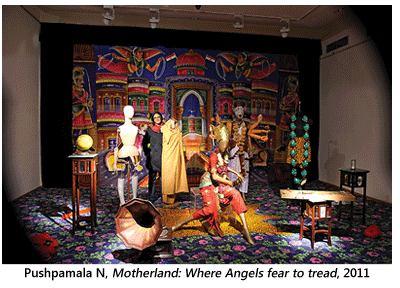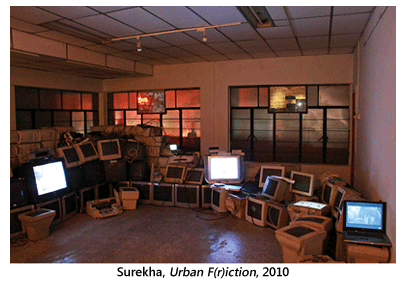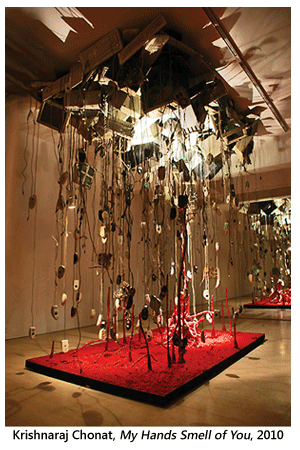- Prelude
- Editorial
- A Conversation with Sheela Gowda
- The DIY Artist with a Mission
- Discovering Novel Horizons
- A Conversation with Raqs Media Collective
- Manjunath Kamath
- Jitish Kallat- the Alchemist
- The Artist and the Dangers of the Everyday: Medium, Perception and Meaning in Shilpa Gupta's work
- An Attitude for the Indian New Media
- Weave a Dream-Theme Over Air or a Medium like Ether
- Installation in Perspective: Two Outdoor Projects
- Towards The Future: New Media Practice at Kala Bhavana
- Workshop @ Facebook
- Desire Machine: Creating Their Own Moments…
- Typography: The Art of Playing with Words
- Legend of a Maverick
- Dunhill-Namiki
- The Period of Transition: William and Mary Style
- The Beauty of Stone
- Nero's Guests: Voicing Protest Against Peasant's Suicides
- Patrons and Artists
- The Dragon Masters
- What Happened and What's Forthcoming
- Art Chennai
- Art Events Kolkata
- Winds of Change
- Art Bengaluru
- Mumbai Art Sighting
- Musings from Chennai
- In the News
- Previews
- Ascending Energy, Merging Forms: Works by Satish Gujral
- Re-visiting the Root
- The Presence of Past a New Media Workshop
- Taue Project
ART news & views
Weave a Dream-Theme Over Air or a Medium like Ether
Volume: 3 Issue No: 15 Month: 4 Year: 2011
by CS Shashidhar
How nice it would be for an artist to weave a dream-theme over air or a medium like ether with very little or no material being used and yet it conveyed to the audience ever so comprehensively the creative idea conceived by him stimulating the rods and cones, the skin, the olfactory tissue, the tympanum, the tongue and essentially the soul of the discerning body, all at once?
How thrilling it would be to create a work of art hung in space defying the gravity of the earth with just the might of the creative soul of the artist?
Of course, the elements picked straight from; the biological life, the technological products and byproducts alike and the various principles of physics, chemistry and electronics, besides the techniques and tools of sculpting and painting, have become the tools of the artist of today who has come out in the open making the whole world his workshop.
All the genres of fine arts said and done, despite the myriad expressions through the ages however fulfilling to  the erstwhile audience, by reflecting sensibly a surreal (or virtual?) world of their own sensibilities so as to make them belong there, that the art is complete only with them there has been many a room for creative mind to explore. Despite the voluminous canvases, books, films, tapes and repertoires during every time there was a feeling of vacuum or redundancy craving for more and more innovation.
the erstwhile audience, by reflecting sensibly a surreal (or virtual?) world of their own sensibilities so as to make them belong there, that the art is complete only with them there has been many a room for creative mind to explore. Despite the voluminous canvases, books, films, tapes and repertoires during every time there was a feeling of vacuum or redundancy craving for more and more innovation.
As far as the deconstruction, which was a result of the revolt against the structuralism, was concerned, the genres like cinema, theatre, architecture and literature experienced lot of limitations when a subject of metaphysical idea had to be expressed. Everything, in order to be perceptible and palpable, had to be worked within the parameters of visible reality, audible decibels, staging-framework, meaningful actions and dialogues, centre of gravity, covenant grammars and syntax and so on, of course with some scope for allegory. This in a way helped the artist to realise the freedom he'd got over the medium of canvas, with the brushes and colours to express an idea churned out from his own emotions or spiritual longings whose transformation to bring into the visible plane had to be as subtle as the idea itself. The motifs of surrealism too had the bearings of theatrical character which needed to be outgrown. Any reflection of the existent world in a work of art, whether live or dead, was later believed to be anathema whenever an avant-garde was sought. This gave rise to abstract expressionism of non-figurativeness.
But this was the long journey from realism to abstract expressionism, and now what? How much of non-figurativeness?
Returning into these two genres or sojourning the intermittent styles would not satisfy the desire to grow in terms of visual yearning for novelty.
The expressions through sculpture too had its satiating effect in the artist as well as the ardent-intellectual audience who needed some breakthrough from prosaism.
Cameras, scanners, CNC (computer numerical control) technology and other replicating machines posed new challenge to the artist.
Of course, the design of a machine starts with an idea based on a principle of science.
Each time a design of a machine with a particular purpose of manufacturing of a product or a component was achieved, man set out to either advance its design or design a new one with a different component in mind.
Artist as a champion of the cultural society should take these developments into cognizance and design a work of art. Creating an avant-garde is like inventing a new machine and a work of art of that order is like a functioning zygote or a new born child, nascent and complete, yet perpetual as it keeps evoking emotions from the audience for as long as it's exhibited.
He needs to look out for new visual exercise appertaining to the time, culture and the technology, whose output would, obviously depend upon his own genetic endowment, and inherent and acquired intellect.
Anyway, the world of graphics armoured the artist of our time with an unprecedented suavity. The transformation process of analogue to digital swept the whole world, the latter enabling the angstrom-precise imagery, the pixels far beyond the pigments became visible enabling the monitoring of the image quality as well as the economy.
The metamorphosis of the artist's sketch of theme-visualization into the graphics could be readily done through Photoshop, CorelDraw, Maya and other soft-tools. The process of transformation of the idea into design and the design into its physical product became ever so spontaneous. Show a Sylvester Stallone and he can be reproduced in Maya in every possible action, next you can make a movie of Stallone without the actor!
The motherboard coming handy as an alternate memory site, the network as the extended nervous system and the search-engines becoming the online archives and libraries, the artist as an intellectual; or an inventor who's engrossed into inventing a new formula, a design or a machine,  had to exercise his capacity to bring out new visual splendour beyond all permutations and combinations of the output of all these aides.
had to exercise his capacity to bring out new visual splendour beyond all permutations and combinations of the output of all these aides.
It has to be, A Work of Art in the Age of Mechanical Reproduction.*
It's just the visual splendour which stands out completely new, having no resemblance to anything in the past, by style or theme was what was expected from the new artist.
The tools that the new artist was endowed with were too many, not to mention the tools of artificial intelligence with other technological ones were included too.
He just needed to be inventive with his idea.
Hence the artist of the new age looked beyond the usual material in the process of expressing his ideas that he would otherwise end up doing what machines could do efficiently, the process of the transformation of the idea into its visible output should be as innovative as the idea itself.
However, he learnt it that he could always use the machines as the aides in his theme-execution. The surge of new sensibilities as a result of the information technology and mass media had its influence too.
Instead of painting the whole theme with the help of paint and brush, he started using prints of the images photographed and worked (manipulated) in computer graphics, and later, on the same canvas he fixed the surface with some materials like metal foils, shells, bones etc and, finally painting over this collage with acrylic or so to define his theme. Thus earlier impasto was replaced by more obvious textures.
The triumph he had once achieved during surrealism and after by discovering that within the framework of the canvas he could confine an image million times larger than the real size of the canvas itself unlike it's seen through the camera viewfinder by outgrowing the limitations of the normal perspective and realistic motifs, and after a practice of this for nearly a century now through various styles up to the recent abstract expressionism there must have been a desire or something prodding him to look up more optimistically and leap out of the framework of the canvas, as far as expressing his creative idea that gave more proximal feel with its dimensions, appearance and character and would be so philanthropic that it touched the audience deep in the roots of his senses.
He had, during the age of deconstruction, already denounced the ecclesiastical order and influence to work on themes derived from his own deep analogy of life and the resulting philosophical essence, unlike what he had been doing until then- fulfilling the dreams of the kings or the vicars. The democracy enhanced his position as a citizen providing him the freedom to express where otherwise the abstraction whatsoever, whether in music, fashion, architecture, painting or sculptor would not be plausible.
(However, the whole movement of structuralism and deconstruction, and the liberation obtained later against the influence of the rulers and the religious leaders by the artists was happening in Europe, whereas, leave alone India, even the American continent had been unaffected. Europe where most of the machines were invented resulting in the fiscal abundance and cultural euphoria, and also fighting for power like the CNS (central nervous system) of the whole world conducted its character soon over the rest.)
We have, ever since been carried over by the sensibilities that began there and pervaded into our world, whether it is abstract expressionism or the new media art. This phenomenon is most illustrious that there has been a clear and visible chasm between Indian Modernists and the original (also traditional) Indian Art.
It's not satirical when someone points at our bullock-carts which are still used in the transportation, along with Volvos, BMWs and Mercedes Benzes, but it's rather a look at the Indian way of living.
While cajoled by the information technology and technology in general one side and on the other with an irrepressible feeling or urge to reach out touching the nerve through all the sensory organs of the audience to gain his fuller empathy, artist with his collaborative (what used to be referred to as collage so far) skills to use the machine and its output as mere elements or tools of execution, in addition to his primitive tools such as paint and sculptural accessories, and also the natural objects, the New Artist has discovered a new genre or means of expressing where in a single work of art there would be a symphony of poetical, literary, theatrical, architectural and musical oeuvre.
He has thus explored the untrodden spaces around the various forms of arts, calling a summit of the other participants such as poets, musicians, architects, theatre performers to join hands in his endeavour.
'Performance was not exclusively related to the canvas: the cross-fertilization between theater, dance, film, video, and visual art was essential for the birth of Performance art', writes Michael Rush in his book New Media in Art, published by Thames & Hudson.
The artist's liberation becomes complete with the new media wherein he would first think about a concept, dream and visualize it, when the suitable media then strikes his mind which he would later express with.
Installation of various natural objects- both perishable and non-perishable along with artificially constructed materials- sometimes even paintings, prints or sculptures especially made for the purpose, live performance or action with sound effect which will be ephemeral or such an event captured by the video shown in an auditorium repeatedly or actual video-installation of an idea, and many other modes of expression have been in practice today.
Why paint flesh? Show it in real. A painting of flesh might talk about the skills of the artist who painted it,  whereas a flesh installed in a gallery smells the whole idea why the artist has installed it. Since he has done it there and you have gone to his concert you'd perceive the ideas more really and comprehensively.
whereas a flesh installed in a gallery smells the whole idea why the artist has installed it. Since he has done it there and you have gone to his concert you'd perceive the ideas more really and comprehensively.
Many of the socio-cultural, mundane and political themes have found, more touchy expression.
However the minimalism or the 'absurd in this mode of abstraction' like in other genres of modern and post-modern period, has been a concern that has bothered the critics of this new art form, sometimes making it difficult to decide whether a work is a true art or rubbish.
Most of the artists of the state of Karnataka have been quite versatile and trying out many of the genres within the new media, they include Pushpamala, Surekha, BH Srinivasa Prasad, Krishnaraj Chonat and Umesh Maddanahalli. Many a time very personal and sensitive subjects have been dealt with even if they have chosen a vast arena for their expressions. Whereas Umesh with his Rights/Riots goes daring in his critique about the Gujarat Riots that tore the secular fabric of the country. Surekha's Urban F(r)ictions (2010) like most of her earlier works delve into herself as a denizen of the global city of Bangalore, in a single video installation she intertwines various aspects of a city and its dweller who are both the direct subjects of change due to globalization. Krishnaraj Chonat's My Hands Smell of You (2010) and other works under this title installed at Gallery SKE were vehement about the disasters the greed for development and technology bring about, which always antagonistically stand against nature. Krishnaraj's works at the sight of it sending a shudder with its appalling and straight forward message are beautiful in other sense which, like always, stand as examples to his adeptness in execution, as an artist and a craftsman he gives utmost importance to the aesthetics of modern period than the post-modern.
The state of Karnataka like most of the Indian states is diverse in its culture, its capital being the first choice of most of the intellects of the nation has a potential to involve more artists into the new genre.
Footnote:
* A Work of Art in the Age of Mechanical Reproduction an essay by German cultural critic, Walter Benjamin, who has written elaborately on the technological influence on the work of art.